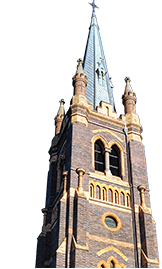Parish
Parish’s Name
- St Thomas More, Werris Creek.
Church’s in Parish
- Werris Creek: St Thomas More (First church – Still part of Quirindi parish 1884-1914; second church 1914-1969; third church 1970)
- Currabubula: St Michael
- Caroona: Our Lady of the Angels
- Spring Ridge: Our Lady of Dolours
Church’s Address
- Dewhurst Street
Parish established
- 1918 (separated from parish of Quirindi)
Priests in the Parish
| Year | Priest |
|---|---|
| 1884-1901 | Fr John (Paul) Pedezoli (Quirindi) |
| 1901-1918 | Archdeacon Thomas Harrington (Quirindi) |
| 1918-1926 | Fr Thomas O’Brian (First Parish Priest St Thomas Church) |
| 1926-1944 | Fr John McDermott |
| 1944-1946 | Fr John Walsh |
| 1946-1953 | Fr Patrick McDermott |
| 1953-1956 | Fr Norman Tuttle |
| 1956-1969 | Fr Stephen Brennan |
| 1969-197 | Fr B P Shanahan |
| 1971-1994 | Monsignor Clarence Fisher (First Parish Priest of St Thomas More) |
| 1994-1995 | Fr Peter Kneipp |
| 1995-2002 | Fr Michael Mullane |
| 2003-2006 | Fr R Perrett |
| 2007- | Fr M Davis |
Parish Associates
Parish History
Following excerpts taken from “Celebrations – Werris Creek” Parish – School Anniversary Magazine 1996
Prior to 1914
The Catholic Church was built about 1884 and was the first church in Werris Creek being situated on the Old Tamworth Road towards the Cemetery. The building which cost $160 new still stands as a private residence.
1914-1926
A second Catholic Church (St Thomas) was built in Dewhurst Street, Werris Creek in 1914 and a separate Parish of Werris Creek was forme din 1918 separating it from the Parish of Quirindi. The Sisters of St Joseph arrive in 1915 and a Convent was built in the north western corner of the Church grounds (the present presbytery). The Sisters of St Joseph arrived in 1915 and a Convent was built in the north western corner of the church grounds (the present presbytery). The Sisters commenced a school in the church building and all classes were held in the one room. On a Friday afternoon the children reversed their desks to become pews for Sunday’s Mass. On Monday morning the desks were changed back again.
St Thomas More Catholic Church
(Excerpts from the minutes of the Special Meeting held in the Parish Hall, St Thomas’ Catholic Church, Wednesday 28 May, 1969)
“Father Shanahan, Parish Priest, officially opened the meeting and thanked the small gathering of parishioners for their attendance. He stated that this occasion was rare for Werris Creek Parish and one that had been long looked forward to by all. Mr Terry Dally, proposed architect, was introduced by Father Shanahan and he spoke at length, regarding what was required in the building of a church, possible costs, and suggested design. It was stated that a set of plans had been previously obtained by Father Brennan for a church but this building would cost in the vicinity of $120,000. It was considered that a very modern church, 400 in capacity and suitable to all the requirements of the Werris Creek parish could be obtained in the vicinity of $80-90,000. The selection of a suitable site was discussed and a Parish Committee was formed…”
Title of New Church
At a Parish General Meeting of 30 May 1970 one of the items on the agenda was to discuss the title of the new church.
Father Shanahan commented, “The present (old) church is dedicated to St Thomas the Apostle. With the building of a new church, the title is either transferred, or with the permission of the Bishop, a new title may be adopted. The Bishop was given permission to change the title if we so wish. As a suggestion I would like to see St Thomas More – the Saint for all Seasons, layman, father, husband, lawyer, classical scholar, Speaker of the House, Chancellor, Greatest Wit of his time, Saint and Martyr.”
Father Shanahan’s wish was fulfilled. The new Church was to be given the title “St Thomas More.”
Explanations on the symbols/furniture in he Church of Saint Thomas More, Werris Creek
The Blessed Sacrament Chapel and Bapistry Windows
The two stained glass windows depict the sacraments of Baptism and the Holy Eucharist. The baptismal windows are essentially a symbol of the purifying effect the descending Holy Spirit gives to the soul in this sacrament. The spirit is represented by a white dove, the source of grace, out of which, like out of a fountain, the purifying water used for the sacrament embraces the tender soul represented by a white cross in the window.
The Blessed Sacrament window depicts both members of the sacrament, the cup holding the wine and the bread underneath. Christ’s real presence is made known by his monogram over the chalice and the fish at the bottom refers to the aspect of this miraculous food.
The Sanctuary Furniture
The timber furniture was originally to be made of railway sleepers bolted together. However, this proved unsuitable due to the weight involved and Tasmanian Oak was substituted. The effect of timber bolted together has been retained.
The adze finish was requested by Father Shanahan, as this type of finish was to be found on furniture during St Thomas More’s lifetime, a period in history known as Early English Medieval.
The Tabernacle
This piece was to embody the symbols of the railway, thus the railway tracks and the wheel of locomotion, a symbol also of God. Associated with this are fences and wheat stalls, symbols of the farming community.
The deep red colour incorporated in the design signifies the association of the church in the Christian community. This is further emphasised by incorporating the Christogram symbol. This symbol has been associated with Christianity from its earliest beginnings and can be found upon tombstones in the catacombs. The form used on the tabernacle is a contemporary version to complement the church. The materials used in the manufacture of the tabernacle are plated brass and enamelled copper.
No further information has been provided at this stage. Please forward any information to the Catholic Schools Office

























